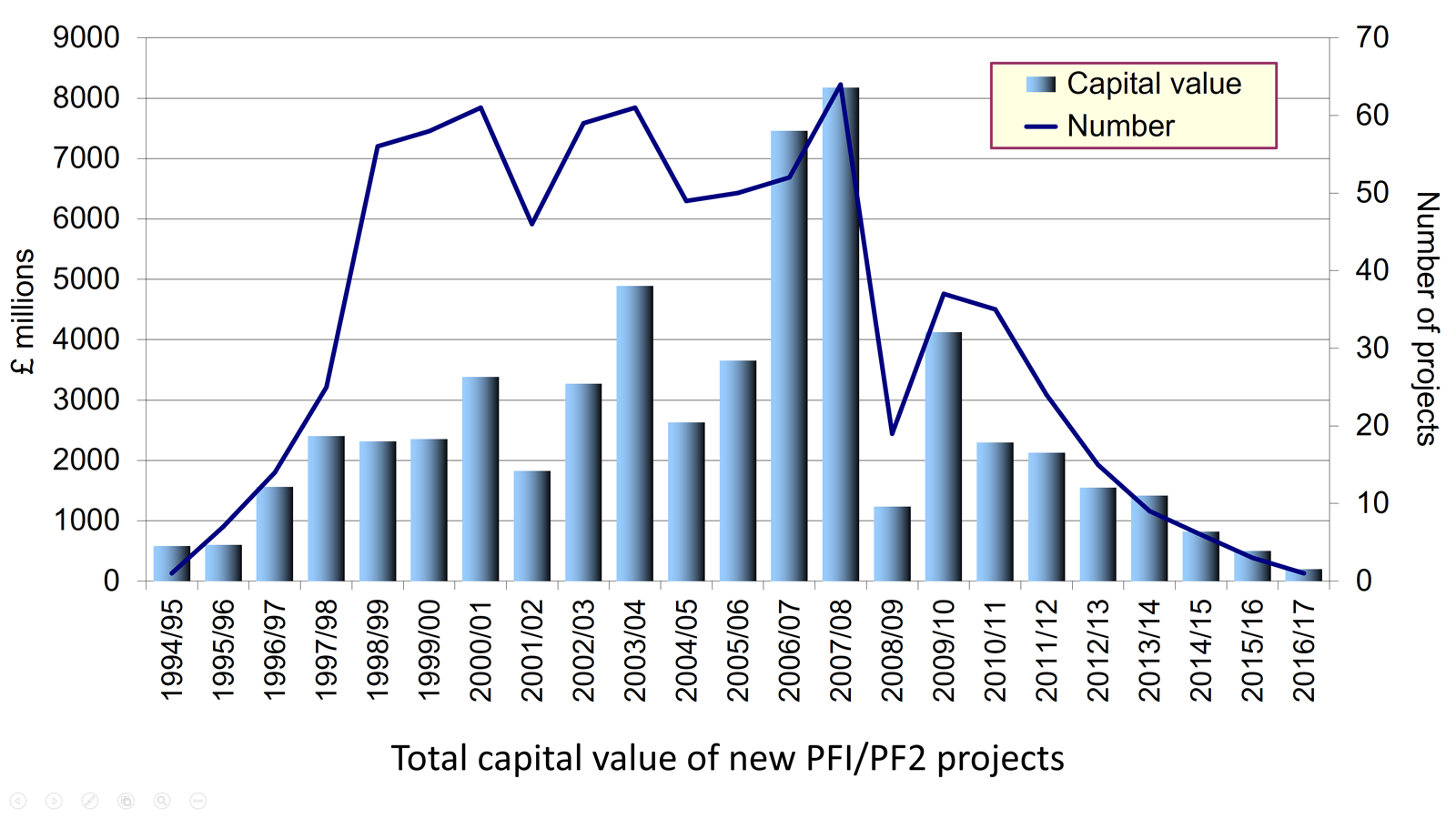 On 15 January 2018, Carillion went into liquidation. It was a major construction, civil engineering and facilities management company in the UK and was involved in a large number of public- and private-sector projects. Many of these were as a partner in a joint venture with other companies.
On 15 January 2018, Carillion went into liquidation. It was a major construction, civil engineering and facilities management company in the UK and was involved in a large number of public- and private-sector projects. Many of these were as a partner in a joint venture with other companies.
It was the second largest supplier of construction and maintenance services to Network Rail, including HS2. It was also involved in the building of hospitals, including the new Royal Liverpool University Hospital and Midland Metropolitan Hospital in Smethwick. It also provided maintenance, cleaning and catering services for many schools, universities, hospitals, prisons, government departments and local authorities. In addition it was involved in many private-sector projects.
Much of the work on the projects awarded to Carillion was then outsourced to other companies, many of which are small construction, maintenance, equipment and service companies. A large number of these may themselves be forced to close as projects cease and many bills remain unpaid.
Many of the public-sector projects in which Carillion was involved were awarded under the Public Finance Initiative (PFI). Under the scheme, the government or local authority decides the service it requires, and then seeks tenders from the private sector for designing, building, financing and running projects to provide these services. The capital costs are borne by the private sector, but then, if the provision of the service is not self-financing, the public sector pays the private firm for providing it. Thus, instead of the public sector being an owner of assets and provider or services, it is merely an enabler, buying services from the private sector. The system is known as a Public Private Partnership.

Clearly, there are immediate benefits to the public finances from using private, rather than public, funds to finance a project. Later, however, there is potentially an extra burden of having to buy the services from the private provider at a price that includes an element for profit. What is hoped is that the costs to the taxpayer of these profits will be more than offset by gains in efficiency.
Critics, however, claim that PFI projects have resulted in poorer quality of provision and that cost control has often been inadequate, resulting in a higher burden for the taxpayer in the long term. What is more, many of the projects have turned out to be highly profitable, suggesting that the terms of the original contracts were too lax.
There was some modification to the PFI process in 2012 with the launching of the government’s modified PFI scheme, dubbed PF2. Most of the changes were relatively minor, but the government would act as a minority public equity co-investor in PF2 projects, with the public sector taking stakes of up to 49 per cent in individual private finance projects and appointing a director to the boards of each project. This, it was hoped, would give the government greater oversight of projects.
With the demise of Carillion, there has been considerable debate over outsourcing by the government to the private sector and of PFI in particular. Is PFI the best model for funding public-sector investment and the running of services in the public sector?

On 18 January 2018, the National Audit Office published an assessment of PFI and PF2. The report stated that there are currently 716 PFI and PF2 projects either under construction or in operation, with a total capital value of £59.4 billion. In recent years, however, ‘the government’s use of the PFI and PF2 models has slowed significantly, reducing from, on average, 55 deals each year in the five years to 2007-08 to only one in 2016-17.’
Should the government have closer oversight of private providers? The government has been criticised for not heeding profit warnings by Carillion and continuing to award it contracts.
Should the whole system of outsourcing and PFI be rethought? Should more construction and services be brought ‘in-house’ and directly provided by the public-sector organisation, or at least managed directly by it with a direct relationship with private-sector providers? The articles below consider these issues.
Articles
Carillion collapse: How can one of the Government’s biggest contractors go bust? Independent, Ben Chu (15/1/18)
The main unanswered questions raised by Carillion’s collapse The Telegraph, Jon Yeomans (15/1/18)
Carillion taskforce to help small firms hit by outsourcer’s collapse The Telegraph, Rhiannon Curry (18/1/18)
Carillion Q&A: The consequences of collapse and what the government should do next The Conversation, John Colley (17/1/18)
UK finance watchdog exposes lost PFI billions Financial Times, Henry Mance and George Parker (17/1/18)
PFI not ‘fit for purpose’, says UK provider Financial Times, Gill Plimmer and Jonathan Ford (6/11/17)
Revealed: The £200bn Cost Of ‘Wasteful’ PFI Contracts Huffington Post, George Bowden (18/1/18)
U.K. Spends $14 Billion Per Year on Carillion-Style Projects Bloomberg, Alex Morales (18/1/18)
Carillion may have gone bust, but outsourcing is a powerful public good The Guardian, John McTernan (17/1/18)
PFI deals ‘costing taxpayers billions’ BBC News (18/1/18)
Taxpayers will need to pay £200bn PFI bill, says Watchdog ITV News (18/1/18)
The PFI bosses fleeced us all. Now watch them walk away The Guardian, George Monbiot (16/1/18)
Carillion’s collapse shows that we need an urgent review of outsourcing The Guardian, David Walker (16/1/18)
Carillion collapse: What next for public services? LocalGov, Jos Creese (16/1/18)
Taxpayers to foot £200bn bill for PFI contracts – audit office The Guardian, Rajeev Syal (18/1/18)
Official publications
A new approach to public private partnerships HM Treasury (December 2012)
Private Finance Initiative and Private Finance 2 projects: 2016 summary data GOV.UK
PFI and PF2 National Audit Office (18/1/18)
Questions
- Why did Carillion go into liquidation? Could this have been foreseen?
- Identify the projects in which Carillion has been involved.
- What has the government proposed to deal with the problems created by Carillion’s liquidation?
- What are the advantages and disadvantages of the Private Finance Initiative?
- Why have the number and value of new PFI projects declined significantly in recent years?
- How might PFI projects be tightened up so as to retain the benefits and minimise the disadvantages of the system?
- Why have PFI cost reductions proved difficult to achieve? (See paragraphs 2.7 to 2.17 in the National Audit Office report.)
- How would you assess whether PFI deals represent value for money?
- What are the arguments for and against public-sector organisations providing services, such as cleaning and catering, directly themselves rather than outsourcing them to private-sector companies?
- Does outsourcing reduce risks for the public-sector organisation involved?
 Some eyebrows were raised when the English Premier League (EPL) recently published the final payments to each of the clubs from the revenue generated by the latest TV deal. The headlines were that Liverpool received the highest individual pay-out of £97,544,336! Cardiff City received the lowest pay-out of £62,082,302. What caught the eye of the headline writers was that the revenue from the lowest pay-out this season (the payment to Cardiff) was greater than the highest pay-out from the previous season (a payment of £60,813,999 to Manchester United).
Some eyebrows were raised when the English Premier League (EPL) recently published the final payments to each of the clubs from the revenue generated by the latest TV deal. The headlines were that Liverpool received the highest individual pay-out of £97,544,336! Cardiff City received the lowest pay-out of £62,082,302. What caught the eye of the headline writers was that the revenue from the lowest pay-out this season (the payment to Cardiff) was greater than the highest pay-out from the previous season (a payment of £60,813,999 to Manchester United).
The 2013-14 season was the first year of the latest 3 year deal for the rights to broadcast EPL games on the television, internet and radio. As part of this deal BSkyB are paying £760 million each year for the rights to broadcast 116 EPL games per season in the UK. BTSport are paying £246 million per year for the rights to broadcast 38 EPL games per season. In addition to selling the rights to broadcast games in the UK, the EPL also separately sells the rights to broadcast games in other countries. For example Cable Thai Holdings paid £205 million for a 3 year deal to show EPL matches in Thailand while NowTV paid £128 million for a similar deal in Hong Kong. In total the EPL earns approximately £1.8 billion per season from the sale of their domestic and international media rights.
The approach taken by the EPL to manage the sale of the broadcasting rights has raised considerable debate amongst economists and policy makers. There are two very different methods that can be used by teams in a league to sell the rights. They are the Individual Sales Model (ISM) and the Collective Sales Model (CSM). In the ISM each club is responsible for marketing and selling the rights to broadcast its home games. The ISM is currently employed by both La Liga in Spain and Primeira Liga in Portugal. In the CSM the rights are sold jointly by the league, federation or national association on behalf of the teams involved. This CSM is currently used by the majority of the football leagues in Europe. The EPL sold the rights for 2013-16 on behalf of the 20 clubs using a sealed bid auction.
 Some economists and policy makers have criticised the CSM, claiming that it is an example of a cartel that simply restricts output and leads to higher prices. Each club is considered to be the equivalent of a firm in a traditional industry. The argument is based on a number of observations about the teams. They:
Some economists and policy makers have criticised the CSM, claiming that it is an example of a cartel that simply restricts output and leads to higher prices. Each club is considered to be the equivalent of a firm in a traditional industry. The argument is based on a number of observations about the teams. They:
• are each separately owned and submit their own individual set of accounts
• compete with each other to buy inputs (i.e. the players) to produce an output (i.e. a match)
• individually market and set the price for the outputs they produce i.e. the ticket for the games and the prices of the merchandise such as football shirts
If this view of the industry is taken, the league or federation looks rather like a restrictive agreement between independent competitors that creates monopoly market power. As evidence to support this interpretation of the CSM, reference is often made to the details of the contract between the EPL and BSkyB and BTSport. As part of this agreement the number of live matches that can be broadcast is restricted to 154.This represents just over 40% of the maximum total of 380 that could be shown. Teams are effectively prohibited from individually selling the rights to matches that are not selected for broadcast in the collective deal as they must seek permission from the EPL. Over ten years ago the Director General of the Office of Fair Trading commented that:
Within the market the Premier League has a major if not unique position. By selling rights collectively…it is acting as a cartel. The net effect of cartels is to inflate costs and prices. Any other business acting in this way would be subject to competition law and I see no reason why the selling of sport should be treated differently.
The EPL has always defended it actions by claiming that any increase in the number of televised games would have a negative impact on the attendance at matches.
An alternative view focuses on the peculiar or unique characteristics of sports leagues. In particular it is argued that sport is unusual because the level of co-operation required between the teams and a league to produce matches is far greater than that required by firms in other industries to produce output. Agreements have to be made about issues such as the timing and venue of the games as well as the rules under which they will be played. However unlike a traditional cartel arrangement these agreements do not simply control and restrict output. They also improve the entertainment value of the game and hence the quality of the product. Some authors have argued that because of these unique characteristics, the league rather than the individual team should be considered as the equivalent to a firm in a more traditional industry. In this ‘single entity theory’ teams are viewed as divisions of a single organization i.e. the league. The league is treated as a natural monopoly that legally owns the broadcast rights of the clubs rather than a cartel of separate firms. Others have argued that it is more sensible to think of the league as a joint venture between the teams.
Not only are the levels of co-operation required much greater than in traditional industries but it is also argued that competitive balance is important for a successful league. If the same teams always win most of the games then there are concerns that fans will find this boring and it will reduce their willingness to pay to watch matches in either the stadium or on television. It is argued that the CSM makes it easier to distribute the TV money more equally and so helps to maintain competitive balance in a league. The White Paper on Sport published by the European Union in 2007 stated that:
Collective selling can be important for the redistribution of income and can thus be a tool for achieving greater solidarity within sports.
The debate continues about whether the CSM used by the EPL is an example of a restrictive cartel which acts against the public interest or a business practice that helps to improve the quality of the product for the customer.
Premier League clubs earn record-breaking sums thanks to TV bonanza The Telegraph (14/5/14)
Liverpool top earners over season with £99m – and bottom side Cardiff got £64m (so see what your team received in 2013-14 Mail Online (11/5/14)
Cardiff earn more TV cash than champions Man Utd did in 2013 BBC Sport (14/5/14)
Relegated Cardiff Earn More TV Revenue than Man Utd Tribal Football (14/5/14)
TV Bonanza for Premier League Clubs Pars Herald (18/5/14)
Season of woe hits home in money league Express & Star (15/5/14) .
Questions
- What is a natural monopoly? Draw a diagram to illustrate your answer.
- What is a cartel? Find three real-world examples of cartel agreements.
- It was explained in the article how the EPL sells the rights to broadcast just over 40% of the total number of matches played per season. Draw a diagram to illustrate and explain how this might be an example of a cartel agreement that restricts output and results in higher prices.
- The EPL defends its decision to restrict the number of games that can be televised in its domestic deal by claiming that any increase would have a negative impact on attendance at the matches. To what extent do you think that watching a live game on the television is a substitute for watching it in the stadium? Draw a demand and supply diagram to illustrate a situation where they are strong substitutes. Explain how the concept of cross price elasticity could be applied to this example.
- Outline how a sealed bid auction works. What are the advantages of using a sealed bid auction as opposed to other types of auction.
- Can you think of any other economics arguments that could be used to defend the use of the CSM for the sale of the broadcast rights?
 Two of the biggest publishing companies, Pearson of the UK and Bertelsmann of Germany are to form a joint venture by merging their Penguin and Random House imprints. Bertelsmann will have a majority stake in the venture of 53% and Pearson will have 47%.
Two of the biggest publishing companies, Pearson of the UK and Bertelsmann of Germany are to form a joint venture by merging their Penguin and Random House imprints. Bertelsmann will have a majority stake in the venture of 53% and Pearson will have 47%.
The Penguin imprint, with a turnover of just over £1bn, has an 11% share of the English language book publishing market. Random House has a 15% share, with turnover of around £1.5bn. The new ‘Penguin Random House’, as it will be called, will have nearly 26% of the market, which should give it considerable market power to combat various threats in the book publishing market.
One threat is from online retailers, such as Amazon, Apple and Google, which use their countervailing power to drive down the prices they pay to publishers. Another threat is from the rise of electronic versions of books. Although e-books save on printing costs, competition is driving down prices, including the prices of paper books, which may make publishers more reluctant to publish new titles in paper form.
There has been a mixed reception from authors: some are worried that an effective reduction in the number of major publishers from six to five will make it harder to get books published and may squeeze royalty rates; others feel that an increased market power of publishers to take on the online retailers will help to protect the interests of authors
The following videos and articles look at the nature of this joint venture and its implications for costs, revenues and publishing more generally.
Videos and webcasts
 Penguin and Random House merge to take on digital giants Channel 4 News, Matthew Cain (29/10/12)
Penguin and Random House merge to take on digital giants Channel 4 News, Matthew Cain (29/10/12)
 Penguin and Random House confident merger will be approved BBC News, Will Gompertz (29/10/12)
Penguin and Random House confident merger will be approved BBC News, Will Gompertz (29/10/12)
 Penguin Books and Random House to merge BBC News, Matt Cowan (29/10/12)
Penguin Books and Random House to merge BBC News, Matt Cowan (29/10/12)
Articles
Random House and Penguin merge to take on Amazon, Apple Reuters, Kate Holton (29/10/12)
Pearson’s Penguin joins Random House Independent, Amy Thomson and Joseph de Weck (29/10/12)
Penguin and Random House sign merger deal Financial Times, Gerrit Wiesmann and Robert Budden (29/10/12)
March of the Penguin The Economist, Schumpeter blog (29/10/12)
Penguin chief: News Corp can’t derail Random House deal The Guardian, Mark Sweney (29/10/12)
Penguin and Random House confident merger will be approved BBC News, Anthony Reuben (29/10/12)
And so I bid Penguin a sad farewell Independent, Andrew Franklin (29/10/12)
Questions
- How does a joint venture differ from a merger?
- What types of economies of scale are likely to result from the joint venture?
- How are authors likely to be affected?
- Will the joint venture benefit the book reading public?
- The relationship between publishers and online retailers can be described as one of ‘bilateral oligopoly’. Explain what this means and why it is impossible to determine an ‘equilibrium’ wholesale price of books in such a market.
- What criteria would the competition authorities use to assess whether or not the joint venture should be permitted to proceed?
- What is likely to be the long-term outlook for Penguin Random House?
- Assess the benefits and costs of a News Corporation takeover of the Penguin division? This was an alternative offer to Pearson had it not gone with Bertelsmann. (News Corp. has the Harper Collins imprint.)
Nokia and Microsoft have announced that they are to form a strategic alliance. This will see Nokia using Windows Phone as the software platform for its smartphones. This follows problems with Nokia’s own Symbian software and the success of Apple’s iPhone and Google’s Android software.
Recognising the depth of Nokia’s problems, its new boss, Stephen Elop, sent a memo to staff with apocalyptic warnings. He likened Nokia’s position to one of standing on a burning oil platform about to be engulfed with flames.
So is the alliance with Microsoft the way out of Nokia’s problems? Will it bring problems of its own? The following articles look at the issues.
Nokia to Use Microsoft Software in Smartphones New York Times, Kevin J. O’Brien (11/2/11)
Nokia, Microsoft to Join Forces to Challenge Apple Dominance Bloomberg, Diana ben-Aaron (11/2/11)
 Nokia: ELOP’s challenge Bloomberg, Martin Garner (11/2/11)
Nokia: ELOP’s challenge Bloomberg, Martin Garner (11/2/11)
Nokia falls into the arms of Microsoft The Economist: Newsbook blog (11/2/11)
Nokia and Microsoft sign strategic tie-up Guardian, Graeme Wearden (11/2/11)
Nokia and Microsoft form partnership BBC News (11/2/11)
Is the Nokia/Microsoft horse a stallion or a tired nag? BBC News blogs: Peston’s Picks, Robert Peston (11/2/11)
Microsoft and Nokia announce my dream partnership so why aren’t you all happy? ZDNet (CBS), Matthew Miller (11/2/11)
Questions
- What is meant by a strategic alliance? What forms can a strategic alliance take?
- For what reasons are Microsoft and Nokia forming a strategic alliance?
- How does Nokia hope to benefit from the alliance?
- How does Microsoft hope to benefit from the alliance?
- Why is Nokia’s share of world profits in the mobile handset market much less than its share of total handset sales (see The Economist article above)? Conversely, why has Apple such a large share of world profits in the handset market (just over 50%) and yet only a tiny market share?
 On 15 January 2018, Carillion went into liquidation. It was a major construction, civil engineering and facilities management company in the UK and was involved in a large number of public- and private-sector projects. Many of these were as a partner in a joint venture with other companies.
On 15 January 2018, Carillion went into liquidation. It was a major construction, civil engineering and facilities management company in the UK and was involved in a large number of public- and private-sector projects. Many of these were as a partner in a joint venture with other companies.




